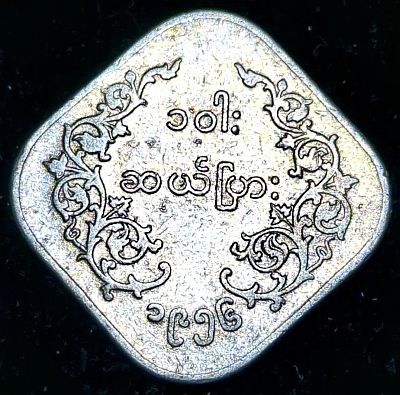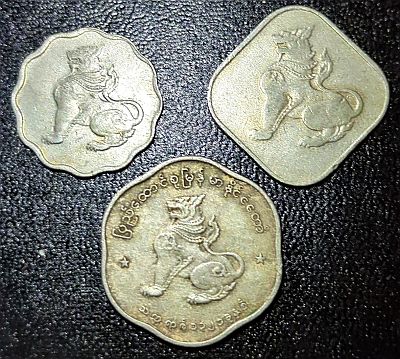A Burmese leograph

Research
Known as Burma prior to 1989 and Myanmar since, the country sits between China, Thailand and Bangladesh. I’ve tried to refer to “Myanmar” in the modern sense, and “Burma” when specifically talking earlier, although in many sources, the two names are used interchangeably. Since the 2021 military coup particularly, Myanmar basically doesn’t have Internet access. So while I normally try to find local sources, particularly for cultural items, that isn’t as much of an option for Myanmar.
I thought I’d share a little of the research trail I went through for this piece. Usually, when I go to write about a coin, it’s mostly a matter of either collating information I already know or finding out the readily available facts and learning as I write. Sometimes, the information is conflicting, or unclear, like with this one. I was of course drawn to the very fierce, Asian looking lion-dragon type creature. but what is it?
According to Numista, it is “Chinze (Burmese half-lion half-dragon)”. NGC agree on it being a Chinze. The only thing I can find on “Chinze” is from several dictionary / Wiktionary sources which explain that it is an “alternative spelling of chinthe”. Colnect call it a “mythical lion (supporter of the coat of arms)”, and now we’re starting to get somewhere.
Taking the Wikipedia description of the state seal, it has a map of the country in the center with sprigs of Eugenia either side. “The sprigs of Eugenia are flanked on each side by an artistic Myanmar lion. The lion on the left side faces towards the left and the lion on the right side faces towards the right”.
Chinthe / Obverse
The Chinthe is a Mythical animal inspired by lions. As legend tells, a princess fell in love with a lion and gave birth to a son. However, the lion soon became feared by the people, and the princess eventually left it. Later, the son killed the lion without knowing that it was his father. Upon returning home, he learned the truth from his mother. To repent, he built a lion statue to serve as the guardian of the temple. This is said to be the origin of the Chinthe.
Wikipedia at least, notes that Chinthe are not mythical creates, but rather Leographs – stylised depictions of natural lions. Most images I can find of this Burmese style of leograph does have a very Chinese-dragon looking head.
Reverse

The reverse features the value and date flanked by sprays or branches. The writing is in Burmese, a script developed from the Mon script, which was adapted from a southern Indian script during the 8th century. The rounded appearance of letters is a result of the use of palm leaves as the traditional writing material. Straight lines would have torn the leaves
Rhombus
The coin’s shape is described as a rhombus. The coin is square with rounded corners, although in this case, the top and bottom are corners (like a diamond) rather than flat sides of the shape. Burma’s coins of this series – 1952-1966, feature a range of shapes. The smallest, 1 Pya, and largest, 50 Pyas and 1 Kyat, are round, of different sizes. The 5 Pyas is scalloped with 12 notches. This 10 Pyas we’ve already described. The 25 Pyas is scalloped with 6 notches (the only circulating coins I can find of that shape).

Here is a photo of the three non-round members of the 1950s series of Burmese coins.


Leave a Reply